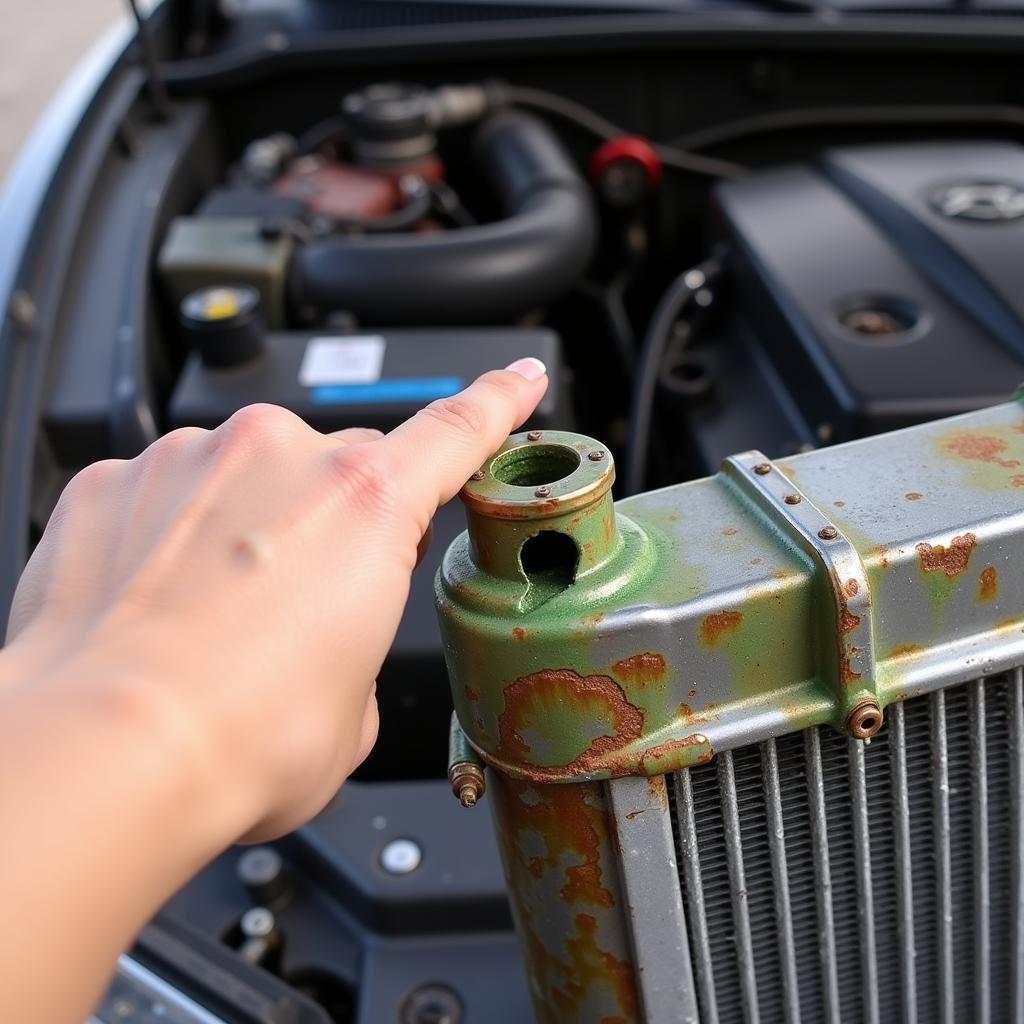Fixing a small hole in your car radiator can seem daunting, but with the right approach, it can be a manageable DIY task. This article will guide you through identifying, assessing, and repairing minor radiator leaks, saving you a potentially costly trip to the mechanic. We’ll explore various methods, from using a radiator sealant to applying epoxy, helping you get back on the road quickly and efficiently.
Identifying a Small Radiator Leak
Before you start fixing a small hole in a car radiator, you first need to confirm that’s the source of the problem. Look for these telltale signs:
- Low coolant levels: Regularly check your coolant reservoir. A consistent drop indicates a leak somewhere in the system.
- Visible coolant: Look for green, orange, or yellow fluid pooling beneath your car, particularly after it’s been parked for a while.
- Overheating: A leaking radiator can lead to overheating, which can cause serious engine damage. Monitor your temperature gauge carefully.
- Sweet smell: Coolant has a distinct sweet odor. If you notice this smell inside or around your car, it’s a strong indicator of a leak.
Once you suspect a radiator leak, pinpoint the exact location. A small hole might be difficult to spot, so thoroughly inspect the radiator fins, seams, and connections.
 Identifying a Small Hole in a Car Radiator
Identifying a Small Hole in a Car Radiator
Methods for Fixing a Small Hole in a Car Radiator
There are several ways to address a small radiator hole, each with its own pros and cons. Choosing the right method depends on the size and location of the hole, as well as your available resources and skill level.
Using Radiator Sealant
Radiator sealant is a quick and easy temporary fix. It’s a liquid that you pour into your radiator. The sealant circulates through the cooling system and solidifies when it comes into contact with air at the leak point, effectively plugging the hole.
- Purchase a suitable radiator sealant: Ensure it’s compatible with your car’s coolant type.
- Allow the engine to cool completely: Never open the radiator cap while the engine is hot.
- Pour the sealant into the radiator: Follow the instructions on the product label.
- Run the engine: Let it run for the recommended time to allow the sealant to circulate and seal the leak.
Applying Epoxy
For a more permanent fix, consider using epoxy. This method requires draining the radiator and cleaning the area around the hole.
- Drain the radiator: Consult your car’s manual for the proper procedure.
- Clean the area around the hole: Use sandpaper or a wire brush to remove rust and debris.
- Apply the epoxy: Follow the manufacturer’s instructions carefully.
- Allow the epoxy to cure completely: This usually takes several hours.
- Refill the radiator: Use the correct coolant type and concentration.
Professional Radiator Repair
If the hole is too large or you’re not comfortable with DIY repairs, it’s best to take your car to a qualified mechanic. They have the expertise and equipment to diagnose and fix any radiator issue effectively.
How Much Does it Cost to Fix a Small Hole in a Car Radiator?
The cost can vary depending on the repair method and whether you do it yourself or hire a professional. DIY fixes with sealant or epoxy can cost under $50. Professional repairs can range from $100 to $300 or more.
Conclusion
Fixing a small hole in a car radiator can be accomplished with several methods, each varying in complexity and cost. Understanding the options allows you to make an informed decision based on your skills and budget. Whether you choose a quick fix with radiator sealant, a more permanent solution with epoxy, or opt for professional help, addressing the issue promptly prevents further damage and keeps your car running smoothly. For further assistance or professional advice, connect with us at AutoTipPro at +1 (641) 206-8880 or visit our office at 500 N St Mary’s St, San Antonio, TX 78205, United States.
FAQ
- What is the most common cause of small radiator holes? Corrosion and road debris are common culprits.
- Can I drive with a small radiator leak? It’s not recommended, as it can lead to overheating and engine damage.
- How long does radiator sealant last? It’s a temporary fix, typically lasting a few months.
- Is epoxy a permanent fix for a radiator hole? While it’s more durable than sealant, it’s not always a permanent solution.
- How often should I check my coolant levels? At least once a month, or more frequently in hot weather.
- What type of coolant should I use? Consult your car’s owner’s manual for the recommended type and concentration.
- What are the signs of a failing radiator? Low coolant, overheating, sweet smell, and visible leaks are common signs.




Leave a Reply